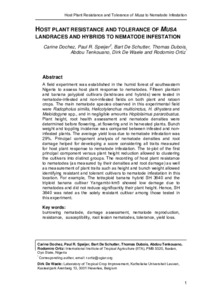| dc.contributor.author | Dochez, C. |
| dc.contributor.author | Speijer, P.R. |
| dc.contributor.author | Schutter, B. de |
| dc.contributor.author | Dubois, T. |
| dc.contributor.author | Tenkouano, A. |
| dc.contributor.author | Waele, D. de |
| dc.contributor.author | Ortiz, R. |
| dc.date.accessioned | 2019-12-04T11:21:35Z |
| dc.date.available | 2019-12-04T11:21:35Z |
| dc.date.issued | 2009 |
| dc.identifier.citation | Dochez, C., Speijer, P. R., De Schutter, B., Dubois, T., Tenkouano, A., De Waele, D. & Ortiz, R. (2009). Host plant resistance and tolerance of Musa landraces and hybrids to nematode infestation. Agrobiodiversity and Genetic Erosion, 137-153. |
| dc.identifier.issn | 1612-9830 |
| dc.identifier.uri | https://hdl.handle.net/20.500.12478/3828 |
| dc.description.abstract | A field experiment was established in the humid forest of southeastern Nigeria to assess host plant response to nematodes. Fifteen plantain and banana polyploid cultivars (landraces and hybrids) were tested in nematode-infested and non-infested fields on both plant and ratoon crops. The main nematode species observed in this experimental field were Radopholus similis, Helicotylenchus multicinctus, H. dihystera and Meloidogyne spp., and in negligible amounts Hoplolaimus pararobustus. Plant height, root health assessment and nematode densities were determined before flowering, at flowering and in harvested plants. Bunch weight and toppling incidence was compared between infested and noninfested plants. The average yield loss due to nematode infestation was 29%. Principal component analysis of nematode densities and root damage helped for developing a score considering all traits measured for host plant response to nematode infestation. The bi-plot of the first principal component versus plant height reduction allowed to clustering the cultivars into distinct groups. The recording of host plant resistance to nematodes (as measured by their densities and root damage) as well as measurement of plant traits such as height and bunch weight allowed identifying resistant and tolerant cultivars to nematode infestation in this location. For example, The tetraploid banana hybrid SH 3640 and the triploid banana cultivar Yangambi-km5 showed low damage due to nematodes and did not reduce significantly their plant height. Hence, SH 3640 was rated as the solely resistant cultivar among those tested in this experiment. |
| dc.description.sponsorship | Flemish Association for Development Cooperation and Technical Assistance |
| dc.description.sponsorship | Directorate-General for Development Cooperation and Humanitarian Aid, Belgium |
| dc.language.iso | en |
| dc.subject | Musa |
| dc.subject | Nematode Infections |
| dc.subject | Yield Losses |
| dc.subject | Tolerance |
| dc.subject | Resistance |
| dc.subject | Susceptibility |
| dc.subject | Land Races |
| dc.title | Host plant resistance and tolerance of Musa landraces and hybrids to nematode infestation |
| dc.type | Journal Article |
| dc.description.version | Peer Review |
| cg.contributor.affiliation | International Institute of Tropical Agriculture |
| cg.contributor.affiliation | Katholieke Universiteit Leuven |
| cg.coverage.region | Africa |
| cg.coverage.region | West Africa |
| cg.coverage.country | Nigeria |
| cg.isijournal | ISI Journal |
| cg.authorship.types | CGIAR and advanced research institute |
| cg.iitasubject | Food Security |
| cg.iitasubject | Plant Diseases |
| cg.iitasubject | Plant Health |
| cg.iitasubject | Plantain |
| cg.iitasubject | Banana |
| cg.accessibilitystatus | Limited Access |
| local.dspaceid | 95983 |

